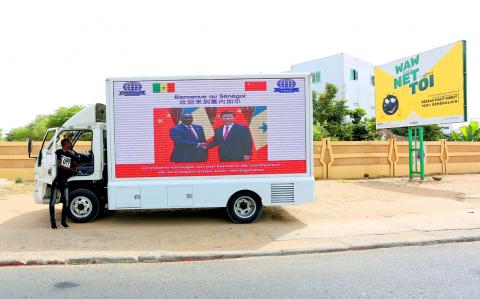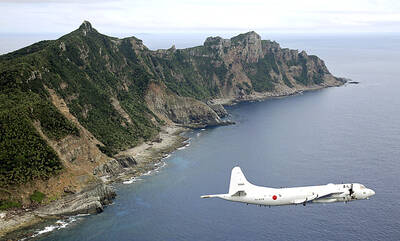Chinese President Xi Jinping (習近平) was to arrive in Africa on a four-nation visit yesterday seeking deeper military and economic ties while his rival in a bitter trade war, the Trump administration, shows little interest in the world’s second most populous continent.
This is Xi’s first trip abroad since he was appointed to a second term in March with term limits removed, allowing him to rule for as long as he wants, which rang familiar to some of Africa’s long-entrenched leaders.
China is already Africa’s largest trading partner and it opened its first military base on the continent last year in the Horn of Africa nation of Djibouti, which this month launched a China-backed free trade zone it calls the largest in Africa.

Photo: Reuters
After surpassing the US in arms sales to Africa in the past few years, China this month hosted dozens of African military officials for the first China-Africa defense forum.
Xi is stopping in Senegal and then Rwanda ahead of his participation in a summit of the so-called “BRICS” emerging economies in South Africa that starts on Wednesday.
The summit comes amid the US’ trade war with China and tough trade negotiations with other key economic partners.
Last month, the foreign ministers of BRICS members Brazil, Russia, India, China and South Africa criticized what they called a “new wave of protectionism,” saying that US measures undermine global trade and economic growth.
Xi’s Africa visit also highlights China’s sweeping Belt and Road Initiative that envisages linking Beijing to Africa, Europe and other parts of Asia via a network of ports, railways, power plants and economic zones.
While such high-profile projects bring badly needed infrastructure and generate economic growth, US officials and others have warned that African nations are indebting themselves to China.
China’s government, banks and contractors from 2000 to 2015 loaned more than US$94 billion to African governments and state-owned companies, the China Africa Research Initiative at Johns Hopkins University said.
“Public debt in the median sub-Saharan African country rose from 34 percent of GDP in 2013 to an estimated 53 percent last year,” a report released in January by Chen Wenjie and Roger Nord of the IMF said.
From oil in nations such as Nigeria and Angola to rare minerals in the Democratic Republic of the Congo, Africa’s natural resources are a major draw for China’s economy, the world’s second-largest behind the US.
However, China’s voracious appetite for resources such as timber and ivory has taken its toll on Africa’s environment, often with the help of corrupt local officials.
On his first visit to a West African country, Xi is to meet with Senegalese President Macky Sall.
Senegal had economic growth of 7.2 percent last year, the IMF said, adding that the nation’s largest trading partner is the EU, notably France.
The stop highlights China’s interest both in Francophone Africa and in Atlantic Ocean ports, while Senegal positions itself as a gateway to the region.
Already, a Chinese-backed industrial park has appeared outside the capital, Dakar, while rail and road links are being improved as part of an ambitious plan to reach the other end of the continent in Djibouti.
Xi then moves on to Rwanda, becoming the first Chinese president to visit the landlocked East African country, whose economy grew by 6.1 percent last year. He is to meet with Rwandan President Paul Kagame and visit a memorial for Rwanda’s 1994 genocide, which killed more than 800,000 people.
The Chinese leader is then to make his third state visit to South Africa for the BRICS summit.
South Africa’s economy, one of Africa’s largest, grew just 1.3 percent last year amid a drop in investor confidence, because of a corruption scandal around former South African president Jacob Zuma, who resigned in February.
Finally, Xi is to stop in the Indian Ocean island nation of Mauritius, whose economy grew by 3.9 percent last year.
China’s economic push is to continue in September with the Forum on China-Africa Cooperation, which brings together dozens of heads of state.

MISINFORMATION: The generated content tends to adopt China’s official stance, such as ‘Taiwan is currently governed by the Chinese central government,’ the NSB said Five China-developed artificial intelligence (AI) language models exhibit cybersecurity risks and content biases, an inspection conducted by the National Security Bureau (NSB) showed. The five AI tools are: DeepSeek, Doubao (豆包), Yiyan (文心一言), Tongyi (通義千問) and Yuanbao (騰訊元寶), the bureau said, advising people to remain vigilant to protect personal data privacy and corporate business secrets. The NSB said it, in accordance with the National Intelligence Services Act (國家情報工作法), has reviewed international cybersecurity reports and intelligence, and coordinated with the Ministry of Justice Investigation Bureau and the National Police Agency’s Criminal Investigation Bureau to conduct an inspection of China-made AI language

LIMITS: While China increases military pressure on Taiwan and expands its use of cognitive warfare, it is unwilling to target tech supply chains, the report said US and Taiwan military officials have warned that the Chinese People’s Liberation Army (PLA) could implement a blockade within “a matter of hours” and need only “minimal conversion time” prior to an attack on Taiwan, a report released on Tuesday by the US Senate’s China Economic and Security Review Commission said. “While there is no indication that China is planning an imminent attack, the United States and its allies and partners can no longer assume that a Taiwan contingency is a distant possibility for which they would have ample time to prepare,” it said. The commission made the comments in its annual

‘TROUBLEMAKER’: Most countries believe that it is China — rather than Taiwan — that is undermining regional peace and stability with its coercive tactics, the president said China should restrain itself and refrain from being a troublemaker that sabotages peace and stability in the Indo-Pacific region, President William Lai (賴清德) said yesterday. Lai made the remarks after China Coast Guard vessels sailed into disputed waters off the Senkaku Islands — known as the Diaoyutai Islands (釣魚台) in Taiwan — following a remark Japanese Prime Minister Sanae Takaichi made regarding Taiwan. Takaichi during a parliamentary session on Nov. 7 said that a “Taiwan contingency” involving a Chinese naval blockade could qualify as a “survival-threatening situation” for Japan, and trigger Tokyo’s deployment of its military for defense. Asked about the escalating tensions

DISPUTE: A Chinese official prompted a formal protest from Tokyo by saying that ‘the dirty head that sticks itself out must be cut off,’ after Takaichi’s Taiwan remarks Four armed China Coast Guard vessels yesterday morning sailed through disputed waters controlled by Japan, amid a diplomatic spat following Japanese Prime Minister Sanae Takaichi’s comments on Taiwan. The four ships sailed around the Senkaku Islands — known as the Diaoyutai Islands (釣魚台) to Taiwan, and which Taiwan and China also claim — on Saturday before entering Japanese waters yesterday and left, the Japan Coast Guard said. The China Coast Guard said in a statement that it carried out a “rights enforcement patrol” through the waters and that it was a lawful operation. As of the end of last month,